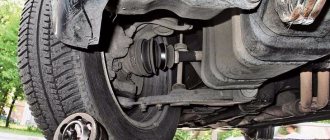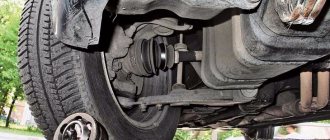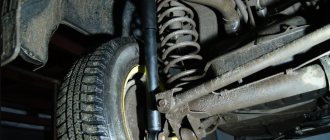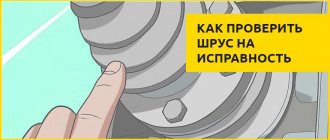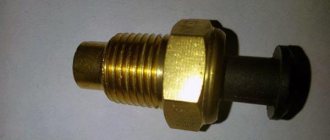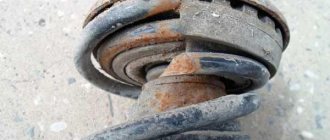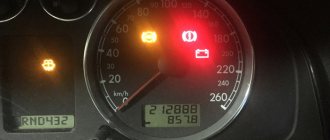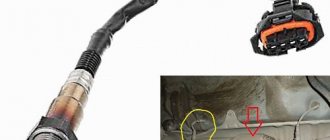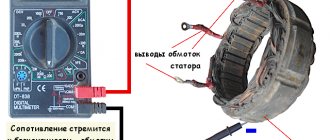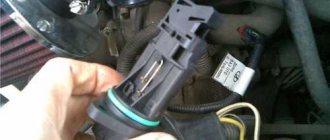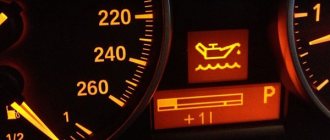Is it dangerous to drive a car when its CV joint is creaking? What could happen from this?
If there is a crunch in the suspension , the first thing you need to do is determine which hinge is crunching. We have two external and two internal. If a crunching sound is heard when turning the wheel, then the outer CV joint on the side of the wheel where the sound is coming from is faulty. If a crunching noise appears during acceleration, braking and when driving under load (for example, uphill), then it is internal. If the boot is torn, services recommend changing the CV joint. But you can wash it in gasoline, buy a new boot and fill it with lubricant. In most cases, the CV joint will serve you for more than one year after this. But if you take it off and it dangles and sloshes, then its life is over. It needs to be replaced with a new one.
The CV joint crunched: what could this lead to?
It cannot crunch indefinitely, since sooner or later the hinge will fall apart under the pressure of the load. You will immediately understand when this happens. There will be a loud cutting sound of metal breaking. If the inner CV joint falls apart, the car will simply stop, as the box will lose traction with the wheels.
In the case of an external CV joint, then (depending on how it falls apart), there may be a chance to drive, but you will no longer be able to turn towards the dead joint. If the joint falls apart at speed, you can get into an accident, so don’t let it get to that point.
1200 rub. for the photo report
We pay for photo reports on car repairs. Earnings from 10,000 rubles/month.
Write:
When joint (constant velocity joint) crunches when turning The most important thing in this case is to find out which CV joint is crunching , because front-wheel drive cars have as many as four “grenades,” as this unit is popularly called. It is also important to understand whether it is the CV joint that is the source of the unpleasant sounds or another part of the car’s suspension. Next, we will try to systematize the information and shed light on the issue of diagnosing and repairing the constant velocity joint of a machine.
Types and design of CV joints
Before we move on directly to describing the signs and causes that indicate problems with CV joints, we need to find out what they are for and what they are. This will make it easier for you to understand how to diagnose and repair them in the future.
Types and location of CV joints
The job of any constant velocity joint is to transmit torque between the axle shafts when they are at different angles at different times. CV joints are used in front-wheel drive and all-wheel drive vehicles to allow the front wheel to turn and rotate under load. There are several types of hinges, but we will not dwell on this in detail. It is important to know that, basically, they are divided into internal and external . Any front-wheel drive car has only four CV joints - two internal and two external, in pairs on each front wheel. The task of the internal one is to transmit torque from the gearbox to the shaft. The task of the external one is to transmit torque from the internal joint directly to the wheel.
a tripod inserted into it - a set of needle bearings operating in three planes. The main shaft (from the “glass” side) is inserted into the gearbox, and another axle shaft is inserted into the tripod, to which torque is transmitted. That is, the design of the internal CV joint is simple, and, as a rule, problems with it arise infrequently. The only mandatory condition for the normal operation of the hinge (this also applies to the external “grenade”) is the presence of lubricant inside it and the integrity of the boot. You can read about choosing a lubricant in a separate article.
Inner and outer CV joints paired
The outer CV joint is a more complex and fragile structure. On one side it is connected to the internal hinge through the axle shaft, and on the other - directly to the hub through its own splined shaft. The design of the outer hinge is based on a ball cage . It can rotate within the angular ranges specified by the design. It is the ball mechanism that is most often the reason why the CV joint crunches. A boot is placed on the body of the external “grenade”, which reliably protects the insides from dust and dirt. The normal operation of the device directly depends on this, and according to statistics, it is a torn boot that is the root cause of the complete or partial failure of this mechanism.
A little about the nature of the problem
Is it possible to change the CV joint boot without making a video?
A CV joint is necessary to transmit rotation between the axle shafts with a constant change in the angle between them. The part is used in front-wheel drive and all-wheel drive vehicles. The drive wheel in such cars must not only rotate, but also turn, and also lower and rise on a spring. Such hinges allow you to do all this.
The design of this unit consists of three main components:
- The outer housing, which is made in the shape of a bowl and is connected to the axle shaft.
- Inner ring. It has a spherical shape. There are six grooves on it, thanks to which the clip is attached to the outer casing.
- Six small balls in the separator. They are located between the bowl holder and the machines.
The problem is that during operation, with the constant “walking” of the balls in the structure, wear and small scuffs form. The movement of the balls becomes more free, which leads to a characteristic sound. Even inexperienced drivers will be able to determine the presence of this problem. You may hear clicking sounds accompanied by vibration or whistling. In most cases, the sound will resemble the crunching of metal.
How to identify a crisp CV joint
Finding out which “grenade” crunches is quite simple. First of all, you need to understand that the characteristic crunching or creaking noise when turning is produced by the outer CV joint. The inner joint may make a clicking noise on a straight road. We will touch on diagnostic algorithms below.
The crunching sound of the outer CV joint usually occurs when the driver turns with the wheels fully or strongly turned (in their direction). This is especially audible if you also “give on the gas” at this time. At this moment, the hinge experiences maximum or close to this load, and if it is faulty, then the mentioned sounds occur. Externally, this may manifest itself in the fact that you will feel “kickback” in the steering wheel when turning.
As for internal CV joints , their failure is more difficult to diagnose. Usually a similar sound comes from them when driving on an uneven road, and the deeper the holes the wheel gets into, the greater the load the joint experiences, and accordingly, the more it crunches. In some cases, a malfunction of the internal CV joint is diagnosed by vibration and “twitching” of the car during acceleration and at high speeds (about 100 km/h or more). Even when driving on a straight and level road (symptoms resemble a situation when the wheels are not balanced).
Next, let's move on to answering the question of how to determine which CV joint is crunching, internal or external. There are several verification algorithms. Let's start with the outer hinges.
Definition of a crunching sound from an outer CV joint
Outer CV joint design
It is necessary to choose a flat area on which you can drive a car. Turn the wheels to one side as far as they will go and drive off quickly. This will put more stress on the hinge, and if it is faulty, you will hear a familiar sound. By the way, you can listen to it yourself (with the windows open) or with an assistant so that he is near the wheel while the car is moving. The second case is especially good for diagnosing right CV joints, since the sound from there reaches the driver worse. However, similar procedures can be carried out on the road or in the field, so as not to bother and look for an additional place for tests.
When turning the car to the left , the right outer CV joint will crunch , and when turning to the right , the left one . This is due to the fact that at this moment the corresponding hinges are the most loaded, since most of the mass of the machine is transferred to them, subject to the creation of significant torque. And the greater the load, the louder the sound. However, in rare cases the opposite happens. Therefore, it is advisable to listen to which side the noise is coming from, outside the car,
Is it possible to repair the CV joint or just replace it?
In practice, repair of a CV joint is impossible due to the high precision of its manufacture, which involves the selection of parts. A hinge assembled from disparate parts will be able to work somehow, but we can’t talk about noiselessness and reliability.
A worn-out assembly will have to be replaced as an assembly, since the splined joints on the shaft also wear out, after which the assembly will knock even with new hinges. But it is quite expensive, so it is offered only by original spare parts manufacturers.
Analogs can be supplied in the form of kits consisting of the CV joint itself, boot, metal clamps and special lubricant in the required quantity.
How the inner CV joint crunches
Inner CV joint design
Internal hinges are diagnosed differently. To determine which CV joint is faulty, left or right, you need to find a straight road with significant potholes and drive along it. If the hinge is broken, it will “knock.”
Let us describe another interesting method for determining how the inner CV joint crunches, which consists in not hanging the wheels, but significantly making the rear part of the car heavier (put a lot of people in, load the trunk), that is, make the front of the car rise and the axle of the inner CV joint curved as much as possible. If in this position you hear a crunching sound while moving, then this is one of the signs of a malfunction of the mentioned unit.
Universal diagnostic method
Diagnosis of a malfunction of the internal CV joint
We present to you an algorithm for another, universal option, how to find out which “grenade” is crunchy. You need to act in the following sequence:
- Place the car wheels level.
- Raise one of the front wheels using a jack.
- Put the car on the handbrake and neutral gear.
- Start the engine, depress the clutch, engage first gear and slowly release the clutch, that is, “move off” (as a result, the suspended wheel will begin to rotate).
- Slowly press the brake pedal, creating a natural load on the joint. If one of the internal “grenades” is faulty, then at this time you will hear familiar knocking sounds on the left or right side. If the internal CV joints are in order, then the car will simply start to stall.
- Turn the steering wheel all the way to the left. Slowly press the brake pedal. If the internal “grenade” is faulty, it will continue to knock. If the outer left CV joint is also faulty, then sound will also be added from it.
- Turn the steering wheel all the way to the right. Carry out similar procedures. If a knocking noise occurs when the steering wheel is turned to the right, it means that the right outer joint is faulty.
- Be sure to put the gear in neutral, turn off the engine, and wait until the wheel comes to a complete stop before lowering it to the ground.
Why does the CV joint start to crunch?
Constant velocity joints, both internal and external, are quite reliable mechanisms, and with proper care their service life can be calculated in years. In some cases, it is even comparable to the service life of the entire car. However, this circumstance directly depends on the care and operating conditions of CV joints.
One of the reasons why joints fail prematurely is an aggressive driving style and/or poor road surface on which the car is driven. As mentioned above, CV joints experience maximum load during sharp turns and high torque from the engine (in other words, when the driver enters a turn “with gas”). As for bad roads, they can damage not only the car’s suspension, but also the CV joint, since a similar situation is created here. For example, the driver accelerates the car through the CV joint, and at this time the wheel oscillates significantly in the vertical plane. Accordingly, under such conditions the hinge also experiences increased load.
Torn CV boot and lubricant splashed from it
The second reason why the CV joint begins to crunch is damage to its boot . This is especially true for the outer CV joint, since it is located in close proximity to the wheel, and accordingly, a significant amount of dust and dirt gets on its body. Under the boot there is a lubricant, which, when moisture and dirt gets into it, immediately turns into an abrasive compound that begins to destroy the surfaces of the internal joint components. This should under no circumstances be allowed. It is necessary to regularly check the condition of the boot in the inspection hole, as well as the presence of lubricant in it. Also check if there is any grease on the wheel rims and parts close to it, because often when the boot is torn, it simply splashes onto the mentioned surfaces.
The third reason why the “grenade” crunches when turning is the natural wear of its internal components under normal operating conditions. This is especially true for cheap Chinese or domestic CV joints. If the mechanism is made of “raw” or low-quality metal, then the service life of such a unit will be short. In the outer hinge, at the point of contact between the balls and the cage, a groove gradually begins to appear. As a result, the designated balls roll very freely, along grooves having a larger diameter than the balls themselves. This rolling is perceived by the human ear as a kind of crunch.
Detecting play on the CV joint
An additional sign of partial failure of the CV joint is the appearance of play on the shaft or axle shaft. It is quite easy to detect it by driving the car into the inspection hole and tugging at the corresponding parts with your hand.
Solution
Having identified a problematic hinge, you need to dismantle it, disassemble it, thoroughly wash it and inspect it. If there are wearouts, damage, or play, the CV joint should be replaced with a new one. There is no point in repairing it. Attempting to sand work surfaces will most likely be a waste of time and effort and will not provide long-term results.
If the part is in order, after washing it should be filled with special lubricant for CV joints and returned to its place. The same should be done with the new hinge. As a rule, for an internal grenade you need about 100... 120 g of lubricant, for an external one - a little less. During assembly, lubricant must also be placed under the boot, and then securely tighten it with clamps on both sides.
Since errors during installation of CV joints can lead to their premature failure, it is better to carry out this procedure for the first time in the presence of a more experienced car enthusiast, who will explain all the intricacies of the process along the way.
When replacing parts that have a symmetrical pair in a machine, you should follow the general rule - change both elements at the same time. This rule should also be applied to CV joints, but with one important clarification: never remove both axle shafts at once to prevent the differential gears from shifting. First, work with one axle shaft and install it in place, only then you can dismantle the second one if necessary.
Cheap hinges, produced under little-known brands, are often made of low-quality metal and are not very carefully assembled; there are also initially defective parts. Such products should be avoided. You should also be careful when choosing where to buy. In the Chinese online store you can purchase the necessary spare parts for transmissions, suspensions and other systems of cars made in China and Europe.
Repair or replacement?
If a lack of graphite lubricant and damage to the boot are detected at a very early stage, repair of the CV joint will be limited to replacing both and washing the joint from any dirt that has fallen into it. This is the best option.
And the cheapest - many car owners change the CV joint boot and lubricant themselves.
For early diagnosis, car owners need to drive the car into an inspection hole at least once every 5 thousand kilometers, where they can see the integrity of the seals and the presence of lubricant under them and on nearby surfaces.
But if the CV joint mechanism itself is damaged, it is unlikely that anyone will undertake to repair it. The design of the hinge itself does not imply adequate restoration - the part will have to be replaced.
The CV joint crunches at low temperatures, what to do?
As a rule, at low temperatures, the cause of crunching of CV joints is poor-quality lubricant, which is not able to perform its functions in extreme cold.
Car manufacturers, when supplying their products to Russia, must take into account the operating conditions.
The frozen lubricant binds the internal elements of the grenade and does not get into all the cavities of the assembly, which is why the crunch appears.
At this moment there is no need to turn sharply and pick up speed; after a few kilometers (20-30) the components will warm up and the crunching will disappear by itself.
But the problem is that the internal grenades warm up quickly, but the external ones at very low temperatures may not warm up and the crunch will remain.
There is an opinion (and not without reason) that the problem is not only in the lubrication, but also in the design of the CV joint itself. The fact is that the lubricant put into the product may not be suitable for this design, while on other car models it works well even at temperatures below -20C.
Some car owners are guilty of using polyurethane boots, which can be installed on some brands of cars instead of rubber ones. They say that in the cold they tan and make sounds. This is a controversial opinion that requires verification.
The problem can be solved by replacing the lubricant; some car owners recommend LM47, VERYLUBE, XADO, they performed well at low temperatures. But it’s difficult to give any advice here, the choice on the market is huge and opinions vary.
But, you need to change the lubricant not just by pressing it under the boot, but completely remove the assembly, disassemble it and press the new lubricant as much as possible instead of the old one into hard-to-reach places. It is these places that cause crunching in severe frost, especially for external grenades.
Consequences of a CV joint crunch
Is it possible to drive with a CV joint crunching? It all depends on the degree of wear and tear. At the initial stage of the breakdown, you can drive, but it is not advisable , since the operation of the unit leads to even greater damage. Therefore, the sooner you try to repair the hinge, the, firstly, it will cost you less (perhaps everything will cost you by replacing the lubricant), and secondly, you will not put the life and health of you and your passengers in the car at risk.
So, the consequences of a CV joint crunching can be:
- Jamming . That is, the CV joint will stop rotating. This is especially dangerous at speed, as you risk losing control of the car, which can be fatal. You can try to wedge the hinge, but the best solution is to replace it.
- Clip break . If we talk specifically about an external grenade, then when it comes to the wedge, the clip simply breaks, the balls scatter, and then the consequences are unpredictable.
- Shaft or axle shaft rupture . In this case, the gearbox will turn only the designated parts, but for obvious reasons the torque will not be transmitted to the drive wheel. This is the most extreme case, and further movement of the car is possible only with a tow truck or tow truck. Naturally, the only correct solution in this case will be to replace the CV joint. And you will be lucky if you only have to change the hinge itself. After all, there is a risk that other parts nearby will be damaged during this accident.
What happens if you ignore the problem?
Constant velocity joints do not fall apart overnight without any preliminary symptoms. Internal defects and wear-outs appear gradually, and the process of destruction of the part takes quite a long time. Therefore, you can drive with crisp joints for some time, but you should, if possible, avoid sudden acceleration and turns at high speed. It is also important not to miss the moment and not allow the grenade to collapse. It is possible that other transmission parts will also be damaged. With a collapsed CV joint, the car will not be able to move, and you will have to deliver it to the garage or service station using a tug or tow truck. In some cases, a jammed CV joint can lead to loss of vehicle control. There is hardly any need to explain what consequences this may cause.
Therefore, if there is a knocking or crunching sound in the suspension, do not put off finding out the reasons and determining the culprit of the problem. Moreover, sometimes a crunching noise simply means a lack of lubrication, and such a malfunction can be fixed relatively simply and cheaply.
How to repair a CV joint
Damage to the internal parts of the hinge most often leads to a complete replacement of the mechanism. However, this only happens with significant wear. In most cases, it is recommended to simply replace the CV joint grease and boot. This is often enough to get rid of the annoying sound and make it easier for the parts to interact.
Therefore, if knocking or clicking sounds appear on one of the four CV joints (we will assume that you have already found out which one), you must perform the following steps:
New inner CV joint
- Drive the car into the inspection pit in order to check the integrity of the boots and the presence of lubricant splashes from under them on nearby surfaces.
- If traces of grease are visible on the boot or other parts, it is necessary to remove the CV joint. Next, disassemble it, remove the boot, wash the internal parts and surfaces, change the lubricant and boot.
- If during the inspection process you find significant play and/or damage to the working surfaces of the parts, you can try to polish them. However, as practice shows, this procedure is ineffective, since you cannot eliminate significant waste with anything. Therefore, the best recommendation would be to completely replace the CV joint .
You can replace the lubricant and boot yourself, as the procedure is simple. The main thing is, when disassembling, do not forget to wash all internal parts and surfaces with gasoline, thinner or other cleaning liquid. And only then apply new lubricant. However, if you are dismantling and replacing the lubricant for the first time, then it is better to have a more experienced car owner or technician with you. Or have him perform the procedure and show you its algorithm. In the future, you can easily cope with such work.
Conclusion
Constant velocity joints are reliable and durable mechanisms. However, during operation, it is necessary to constantly monitor their condition in order to determine in time which CV joint is crunching or making other unpleasant sounds. After all, this indicates a malfunction in its operation. Hinge failure at the initial stage is not critical . You can drive hundreds or even a thousand kilometers with a crunch. However, you should remember that the sooner you repair or replace the CV joint, the cheaper it will cost you. In addition, do not forget about safety. Do not bring the condition of the hinge to a critical state , as this threatens you with a serious emergency situation, especially at high speed. We hope that the above information helped you figure out what to do when the CV joint crunches and accurately determine which one is faulty.
agree. for 1600 it’s definitely not original. AtlantMotors offered me the original for $500 (crazy :haha: :haha:) I asked for the bottom of the computer and after 2 minutes I found it for $50.
In general, I drove with crunching CV joints for a long time... well, a month or two for sure... on different cars. I've never had a spin. changed because I got the crunch. those. I guess I can go. but don’t get stuck in the axle boxes and don’t get into holes too much... try.
Added after 1 minute 5 seconds:
non-original CV joint which is GKN, it is normal. It will definitely last 2 years. vosmilie:
Could a single knock when starting off cause a CV joint failure? This is happening to me now (I checked the suspension is normal)
I also sometimes (very rarely) have a single crunch when starting. Both external CV joints were changed 6 thousand ago. I installed non-original ones - I thought that maybe one of them was unsuccessful. maybe it's not the external joint?
Recommendations
As a rule, the main problem with CV joints is damage to the joint boots. For this reason, their condition must be constantly monitored at every maintenance. Even the slightest damage (cracks, tears, holes and other defects) is not allowed. If such defects are found, the CV joint boot must be replaced immediately. Please note that ignoring this rule leads to breakdown of this unit.
Moreover, if the CV joint crunches, this indicates critical wear. In practice, the problem can be “preserved” by updating the joint lubrication. However, this does not allow us to talk about the reliability and durability of the unit after such maintenance.
We also add that the maximum load on the CV joint is created if the driver accelerates heavily with the wheels turned out. If there is such an opportunity and you need to overcome an obstacle (for example, driving onto a curb or accelerating sharply when turning), it is better to put the wheels as straight as possible in order to reduce the load on the CV joint.
